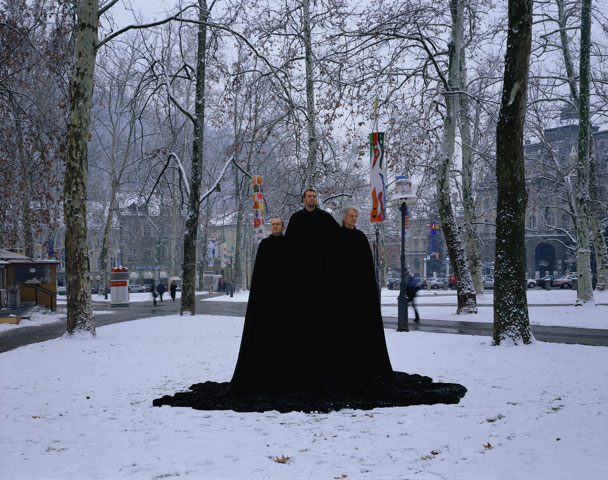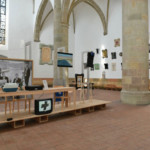Exhibition
in Biel/Bienne / Switzerland
- IRWIN: Like to Like / Mount Triglav, 2004, re-enactment auf der Grundlage des Fotos der Aktion der Gruppe OHO (Milenko Matanović), Mount Triglav, 1968, Farbfotografie, 168 × 199,5 cm. Foto: Tomaž Gregorič, Produktion: Cornerhouse, Courtesy Galerija Gregor Podnar
- IRWIN: Kapital 1991, Ausstellungsansicht National Gallery, Pittsburgh Center for the Arts. Foto: IRWIN archive
- IRWIN: Transnacionala, 1998, Installation, 260 x 520 x 120 cm, Ausstellungsansicht Kunsthalle Osnabrück, Foto: Angela von Brill, Courtesy Galerija Gregor Podnar
- NSK: NSK Passports, 2017, Courtesy NSK
IRWIN is the name of a five-person Slovenian artists’ collective that has been collaborating on numerous groundbreaking projects both within and outside the group since 1983. “How to Read a Map” is the fourth and last part of a project spanning several countries, highlighting various aspects of their collaboration, which encompass a wide range of media such as photography, film, installation, interventions in the public space, painting and publications. From the beginning IRWIN has focused on the relationship, interplay and forms of representation of art and ideology. Their working method requires that each member of the group retains their own artistic form of expression and that at the same time room remains for collaborations with other artists such as Marina Abramović, Andres Serrano, Joseph Beuys or the interdisciplinary collective Neue Slowenische Kunst (New Slovenian Art), NSK for short, founded in 1984. Collaboration and exchange are the basis of both collectives that positioned themselves in the political and cultural scene of the former Socialist Federal Republic of Yugoslavia. Their work is based on an uncompromising analysis and deliberate appropriation of icons as well as political or religious symbols. They question the absolutist claims of these in provocative and ironic ways and deconstruct propaganda strategies by examining the connotations and effectiveness of signs and images and the related social systems.
Following the breakdown of Eastern Europe and the bloody collapse of Yugoslavia the transformation of the Neue Slowenische Kunst (New Slovenian Art) into the NSK State in Time – a utopian state with neither borders nor territory – occurred in 1992. Anyone can join it by acquiring a passport, for its goal is the questioning of nations, identities and borders. In the meantime the NSK State in Time has 15’000 supporters and has made an appearance over and again via various art actions. Among these are the temporary embassies and consulates that have taken place in numerous cities such as Moscow, New York and Berlin and of which one is now opening at the Kunsthaus Pasquart. The debut of the NSK State Pavillon at this year’s Venice Biennale was certainly the highlight to date of this quest.
A key aspect of IRWIN’s by now decade-long activity is their preoccupation with the writing of art history and the examination of how far this too is the product of ideological thinking. At the start of the new century IRWIN began with the work “East Art Map” to analyse the art history of Eastern Europe: in the context of a comprehensive publication and an interactive website the art of eastern Europe since 1945, which until the 90s had largely been ignored, was systematically (re)constructed and put in context. It is obvious that as part of this the approach to the writing of Western art history up to this point had to be revised. IRWIN’s decision to organise the first non-national pavilion at the Venice Biennale in 2017 was a new milestone in their institutional critic’s x-ray of ideologies.
“How to Read a Map” gives an overview of IRWIN’s investigations of the ways in which geo-political developments are reflected in the writing of art history and demonstrates the collective’s biting humour in their approach to the power structures of the art world. IRWIN first came to Biel in 2009 in the context of “Utopics”, the 11th Swiss Sculpture Exhibition where they showed “Outlook: Words from Africa”. Examining migration and its causes, this installation in the public space contained a collection of numerous emails in which inhabitants of the African continent had contacted the NSK State in Time. Now IRWIN is returning to the city with a large exhibition at the Pasquart, the fourth and last part of an exhibition cycle in cooperation with the Galleria civica di Modena, Kunsthalle Osnabrück and the Łaźnia Centre for Contemporary Art Danzig.
Curators of the exhibition: Julia Draganović and Claudia Löffelholz, LaRete Art Projects
The exhibition is accompanied by a publication in the form of an entertaining “IRWIN glossary”, assembled by the exhibition curators and published by the Verlag für moderne Kunst (DT/FR).
Opening hours Wed-Fri noon – 6 pm, Thur noon – 8 pm, Sat/Sun 11 am – 6 pm
Der Name IRWIN steht für ein fünfköpfiges slowenisches Künstlerkollektiv, das seit 1983 zahlreiche bahnbrechende Zusammenarbeiten inner- und ausserhalb der eigenen Gruppe realisiert. “How to Read a Map” ist der vierte und letzte Teil eines länderübergreifenden Projektes, in dem verschiedene Aspekte ihrer Zusammenarbeiten, die vielfältige Medien wie Fotografie, Film, Installation, Interventionen im öffentlichen Raum, Malerei und Publikationen umfassen, beleuchtet werden. Von Beginn an richtet IRWIN den Fokus auf das Verhältnis, Zusammenspiel und die Repräsentationsformen von Kunst und Ideologie. Ihre Arbeitsweise setzt voraus, dass jedes Gruppenmitglied seine eigene künstlerische Ausdrucksweise beibehält und gleichzeitig Raum für Kooperationen mit anderen Künstlern wie Marina Abramović, Andres Serrano, Joseph Beuys bzw. dem 1984 begründeten interdisziplinären Kollektiv Neue Slowenische Kunst, kurz NSK, bleibt. Zusammenarbeit und Austausch sind die Grundlage beider Kollektive, die sich in der politischen und kulturellen Szene der damaligen Sozialistischen Föderativen Republik Jugoslawien positionierten. Ihre Werke beruhen auf einer schonungslosen Analyse und gezielten Aneignung von Ikonen sowie politisch oder religiös besetzten Symbolen. Provokativ-ironisch stellen sie deren Absolutheitsansprüche in Frage und dekonstruieren Propagandastrategien, indem sie Konnotation und Wirksamkeit von Zeichen und Bild und die damit verbundenen Gesellschaftssysteme untersuchen.
Nach dem Zusammenbruch des Ostblocks und dem blutigen Auseinanderfallen Jugoslawiens erfolgte 1992 die Umwandlung der Neuen Slowenischen Kunst in den NSK State in Time: Ein utopischer Staat, der weder über Grenzen noch Territorium verfügt. Jeder kann ihm durch den Erwerb eines Passes beitreten, denn sein Ziel ist es, die Koordinaten der Nationen, Identitäten und Grenzen in Frage zu stellen. Inzwischen hat der NSK State in Time weltweit 15’000 Anhänger und tritt mittels unterschiedlicher Kunstaktionen immer wieder in Erscheinung. Zu diesen gehören die temporären Botschaften und Konsulate, die in zahlreichen Städten wie Moskau, New York und Berlin stattfanden und von denen nun auch eine im Kunsthaus Pasquart eröffnet wird. Das Debüt des NSK State Pavillon auf der diesjährigen Biennale in Venedig bot wohl den bisherigen Höhepunkt dieses Bestrebens.
Ein Schwerpunkt von IRWINs nunmehr jahrzehntelangem Schaffen ist die Auseinandersetzung mit der Kunstgeschichtsschreibung und der Erforschung, inwieweit auch diese das Produkt eines ideologischen Denkens ist. Zu Beginn des neuen Jahrtausends begann IRWIN mit “East Art Map” die Kunstgeschichte Osteuropas zu untersuchen: Im Rahmen einer umfassenden Publikation und einer interaktiven Webseite wurde die bis in die 90er-Jahre vom Westen weitgehend ignorierte Kunst des östlichen Europas ab 1945 systematisch (re)konstruiert und in Zusammenhänge gesetzt. Dass dabei auch der Blick auf die bisherige westliche Kunstgeschichtsschreibung revidiert werden musste, liegt auf der Hand. IRWINs Schritt, den ersten nicht-nationalen Pavillon auf der Biennale in Venedig 2017 zu organisieren, war ein neuer Meilenstein ihrer Ideologien durchleuchtenden Institutionskritik.
“How to Read a Map” gibt einen Überblick über IRWINs Untersuchungen darüber, wie sich geopolitische Entwicklungen in der Kunstgeschichtsschreibung spiegeln und zeigt den beissenden Humor des Kollektivs im Umgang mit den Machtstrukturen der Kunstwelt. Im Jahr 2009 kam IRWIN zum ersten Mal im Rahmen von “Utopics 11. Schweizerische Plastikausstellung” nach Biel und zeigte “Outlook: Words from Africa”, eine Installation im öffentlichen Raum, die eine Sammlung von zahlreichen E-Mails, in denen Bewohner des afrikanischen Kontinents den NSK State in Time kontaktiert hatten, umfasste und sich mit Migration sowie ihren Ursachen auseinandersetzte.
Nun kommt IRWIN mit einer grossen Ausstellung im Kunsthaus Pasquart in die Stadt zurück, die der vierte und letzte Teil eines Ausstellungszyklus in Kooperation mit der Galleria Civica di Modena, Kunsthalle Osnabrück und dem Łaźnia Centre for Contemporary Art Danzig ist.
Kuratorinnen der Ausstellung: Julia Draganović und Claudia Löffelholz, LaRete Art Projects
Zur Ausstellung erscheint eine Publikation in Form eines unterhaltsamen “IRWIN–Glossars” erstellt von den Ausstellungskuratorinnen, Verlag für moderne Kunst (DT / FR).
Öffnungszeiten Mi-Fr 12 – 18 Uhr, Do 12 – 20 Uhr, Sa/So 11 – 18 Uhr
www.pasquart.ch
www.follow-irwin.net
Location:
Kunsthaus Centre d’art Pasquart
Seevorstadt 71 Faubourg du Lac
2502 Biel/Bienne
Switzerland





